September 28, 2016:
We found MANY species at the 42nd annual Alexander H. Smith mycological foray, which we hosted this year at the University of Michigan Biological Station in the Northern Lower Peninsula near Pellston. One of the mushrooms I found was Gliophorus psittacinus, (formerly Hygrophorus) commonly known as the parrot waxcap. It was bright green when I found it, but it loses the green pigment quickly upon harvest, and completely upon desiccation. I was able to capture this image before the green pigment was completely gone. The specimen is now deposited at the University of Michigan Herbarium!
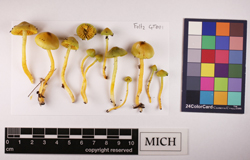
September 1, 2016:
I've been digitizing all of the Cantharellus research specimens I collected and those that were sent to me from around the country over the past four years. I'm digitizing all of the data associated with the specimens, and also imaging the desiccated basidiocarps themselves. This particular specimen dried beautifully, and I am proud to say it is one of my own. :-)
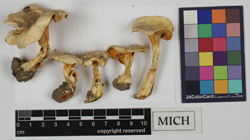

July 22, 2016:
We've had a really dry summer. My best chanterelle spot has only yielded one Cantharellus phasmatis specimen so far. We need rain!
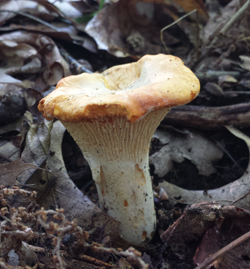
July 6, 2016:
The University of Michigan Herbarium (MICH) currently has more fungal specimens databased (242116) than any institution in the United States besides the USDA National Fungus Collection in Beltsville! GO BLUE!
April 8, 2016:
Today I linked over 400 of Marian Rea's fungal paintings to specimens stored at MICH and uploaded them to the MycoPortal! The paintings are of fungi that she and her husband Paul Rea collected. Paul and Marian were friends of Michigan mycologist Alexander H. Smith, which is how the collections and paintings wound up here at MICH.
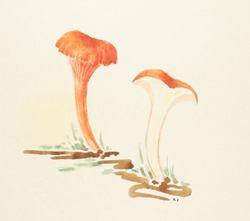
March 8, 2016:
We have begun digitizing our microfungi at the herbarium as part of the NSF-funded Microfungi Collection Consortium TCN digitization project. Our team digitized over 8000 basidiomycete rust specimens in our first month!
February 12, 2016:
The University of Wisconsin herbarium discovered that they held specimens collected by George Washington Carver. It turns out the specimens are part of a widely-distributed exsiccati set, meaning that many herbaria hold Carver's collections including the University of Michigan Herbarium. Here is a specimen from 1901 that we found:

January 5, 2016:
I am now collaborating with my former Volk Lab colleague Eric Walberg to utilize next-generation sequencing techniques to produce molecular data for the chanterelle project. Eric is optimizing our methods now!
May 1st, 2015:
We have completed digitizing our macrofungus collection at the University of Michigan Herbarium. Almost 140,000 collections had their label information digitized and added to our database. These collection records are publicly available.
July 6th, 2014:
Chanterelle season is well underway here in Southern Michigan. I am finding Cantharellus phasmatis and Cantharellus cinnabarinus so far. 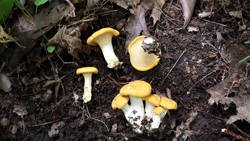
December 1st, 2013:
I am happy to report that 181 collections of Cantharellus were donated to my research project this year that were collected from 24 different states. These collections were made by thirty-two different professional mycologists and citizen scientists. I am extremely grateful for this contribution.
April 3rd, 2013:
Three new species of Cantharellus were discovered in western Wisconsin growing within 20m of one another. The article is published in the March-April volume of Mycologia, the official peer-reviewed journal of the Mycological Society of America (MSA).
February 3rd, 2013:
Winter mushroom foray in Hell, Michigan. I organized and lead a group of 11 dedicated individuals through Pinckney State Recreation Area to look for fungi. Despite the snow and ice, over a dozen different species were found including one edible specimen of Flammulina velutipes.

Foray in Hell. Photo courtesy of James Green.
|






